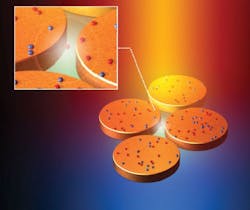CARS method amplifies optical signature of single molecules about 100 billion times
Nanophotonics researchers at Rice University (Houston, TX) have created a unique sensor that amplifies the optical signature of molecules by about 100 billion times. Newly published tests found the device—which has potential utility in biosensing—could accurately identify the composition and structure of individual molecules containing fewer than 20 atoms.
Related: Shrink wrap can boost fluorescent marker detection in biosensing 1000X
The new imaging method uses a form of Raman spectroscopy in combination with an intricate but mass-reproducible optical amplifier. Researchers at Rice's Laboratory for Nanophotonics (LANP) said the single-molecule sensor is about 10X more powerful that previously reported devices.
"The ideal single-molecule sensor would be able to identify an unknown molecule—even a very small one—without any prior information about that molecule's structure or composition. That's not possible with current technology, but this new technique has that potential," explains LANP director Naomi Halas, the lead scientist on the study and the Stanley C. Moore Professor in Electrical and Computer Engineering and a professor of biomedical engineering, chemistry, physics, and astronomy at Rice.
In the research team's study, LANP graduate student Yu Zhang used a two-coherent-laser technique called coherent anti-Stokes Raman spectroscopy (CARS) in conjunction with a light amplifier made of four tiny gold nanodiscs to measure single molecules--a technique dubbed "surface-enhanced CARS," or SECARS.
"The two-coherent-laser setup in SECARS is important because the second laser provides further amplification," Zhang says. "In a conventional single-laser setup, photons go through two steps of absorption and re-emission, and the optical signatures are usually amplified around 100 million to 10 billion times. By adding a second laser that is coherent with the first one, the SECARS technique employs a more complex multiphoton process."
Zhang says the additional amplification gives SECARS the potential to address most unknown samples. That's an added advantage over current techniques for single-molecule sensing, which generally require a prior knowledge about a molecule's resonant frequency before it can be accurately measured.
Another key component of the SECARS process is the device's optical amplifier, which contains four tiny gold discs in a precise diamond-shaped arrangement. The gap in the center of the four discs is about 15 nm wide. Owing to an optical effect called Fano resonance, the optical signatures of molecules caught in that gap are dramatically amplified because of the efficient light harvesting and signal scattering properties of the four-disc structure.
Fano resonance requires a special geometric arrangement of the discs, and one of LANP's specialties is the design, production, and analysis of Fano-resonant plasmonic structures like the four-disc "quadrumer." In previous LANP research, other geometric disc structures were used to create powerful optical processors.
Zhang says the quadrumer amplifiers are a key to SECARS, in part because they are created with standard e-beam lithographic techniques, which means they can be easily mass-produced.
"A 15 nm gap may sound small, but the gap in most competing devices is on the order of 1 nm," Zhang says. "Our design is much more robust because even the smallest defect in a 1 nm device can have significant effects. Moreover, the larger gap also results in a larger target area, the area where measurements take place. The target area in our device is hundreds of times larger than the target area in a 1 nm device, and we can measure molecules anywhere in that target area, not just in the exact center."
Halas says that other potential applications for SECARS include chemical sensing as well as metamaterials research. Scientific labs are likely be the first beneficiaries of the technology, she adds.
Full details of the work appear in the journal Nature Communications; for more information, please visit http://dx.doi.org/10.1038/ncomms5424.
-----
Don't miss Strategies in Biophotonics, a conference and exhibition dedicated to development and commercialization of bio-optics and biophotonics technologies!
Follow us on Twitter, 'like' us on Facebook, and join our group on LinkedIn
Subscribe now to BioOptics World magazine; it's free!


